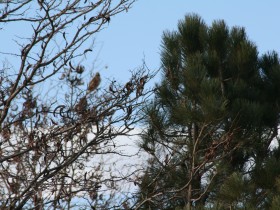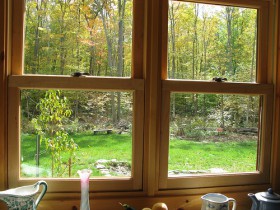621 N Blaine Way, Pueblo West CO 81007

MLS #: 171390
Area: Pueblo West Northside
4 Bedroom(s)
3 Bathroom(s)
2174 Sq Ft
1.21 Acres



Ten Fall Maintenance Tips that will help you keep your home in tip top shape over the winter months.
1- Check your gutters, downspouts and roof. It is hard to tell if your roof has damage because it is so far above your normal view, but you should check it to see if you have any shingles missing, bulging spots or damage to your roof that needs to be repaired. Check that your downspouts and gutters are clear from debris such as leaves and sticks. For those of us with kids that seem to “accidentally” throw their toys on the roof, make sure there are not any toys or balls in the gutter that could stop rain water from draining properly.
2 – Check over the yard and outside of your home. Check the outside of your home for any damage to the exterior (stucco, siding, wood, etc…) As the weather gets colder, unhook the outside hoses and put them away for the winter. Check your sidewalks and patios for any cracks or repairs that may need to be made.
3 – Check Your Air Filters. This is a great time to change the filters in your air conditioner and furnace units. Cover your outside air conditioner unit to prevent damage. Remove window units and seal any windows that have air leaks. You may want to also clean the vents in your dryer as well.
4 – Repair Any Leaking Faucets. Check your kitchen bathroom and laundry faucets for any drips. The money saved by this minor repair far outweighs the money going down the drain!
5 – Check Your Fireplace. Clean out the ashes that may still be in the fireplace. Have a professional clean the chimney to rid it of built up soot and carcinogens that could be dangerous once you begin using it during the cold months. Chimney fires can be easily avoided with regular cleanings and maintenance.
6 – Drain your Hot Water Heater. If your water tends to be hard or has alot of minerals, your tank could be building up with sediments. Make sure rust is not developing in your tank. If your hot water heater is older, you may want to consider a newer more efficient one.
7 – Check Your Windows and Doors. You will want to check for drafts, damage to the window frames or door frames. Seal or caulk the windows to ensure cold air from coming in. You may want to use window plastic for older windows that are drafty.
8 – Clean, Cover and Store Outdoor Furniture. Consider power washing or using Oxy Clean on your outdoor patio furniture before putting them away for the winter. Remove any cushions, umbrellas and other fabric covered items and store those items inside your garage through the colder months to prevent damage to the material.
9 – Sharpen and Service All Power Tools. Have your garden tools sharpened now and ready for spring. Service your lawn mower, weed trimmer and other outside tools that will sit over the winter months..
10 – Fertilize Your Lawn and Winterize Sprinkler System. Apply fertilizer before the weather is too cold. Once you have finished, you will want to prepare your sprinkler system for winter, which could include blowing out the lines, replacing sprinkler heads or repairing broken lines. You will want to have your system working in the spring.
Now that you have your home ready for winter, sit back and enjoy those cooler nights, knowing your are ready for what Mother Nature has ahead.

Eco-Friendly, Carbon Footprint, Global Warming and Energy Efficient. These catch phrases have become part of our vocabulary as we have become more aware of our impact on the environment and our role in protecting it. As a homeowner, there are some simple and inexpensive steps you can take to make your home energy-efficient. Once you start, you will find it is pretty easy to make “green” choices.
Change your light bulbs
By replacing just five incandescent light bulbs with compact fluorescent (CFL) bulbs, you can save $100 per year on electric bills while using 76% less energy and remove greenhouse gases from the environment. The compact fluorescent bulbs are available to replace regular light bulbs, flood lights and recessed lighting.
Buy ENERGY STAR® Appliances
Energy Star qualified appliances, such as refrigerators, washer, dryers, air conditioners, hot water heater and furnaces, meet a higher level of energy efficient set by the Environmental Protection Agency and the US Department of Energy than standard models. According to the Energy Star, if just one in ten homes used Energy Star-qualified appliances, the impact could be compared to planting 1.7 million new acres of trees. And, switching to these appliances is not only good for the environment, but easy on your pocketbook. Although these appliances may cost a little more to purchase, you can recude your energy bill up to $80 per year, per appliance.
Seal Up
Cracks and air leaks represent cash seeping from your doors and windows. Get rid of the air leeks in doors, windows and other cracks by caulking the gaps. This will help decrease your heating and air conditioning bill. But make sure to use silicone sealants as acrylic caulk tends to shrink, while silicone sealants are waterproof and won’t shrink or crack.
Tip – when using caulk, you can make the clean up easier by applying masking or painting tape to the areas around the window, door, and even tubs and then place the caulk where it is needed. Pull the tape away and you have a clean line.
Use less water
Did you know that roughly 60% of a home’s water consumption takes place in the bathroom? The largest culprit is the toilet, which accounts for 27% of your household supply every year. By installing low-flow toilets, shower heads and faucets, you can save thousands of gallons of water each year. In addition, replace leaky fixtures. That slow dripping faucet can waste as much as 2,400 gallons of water per year.
Adjust the thermostat
When setting your home’s thermostat, the rule of thumb should be: turn up the dial in the summer and down in the winter. Lowering the temperature by just one degree will reduce your electric and gas bill. If you use a programmable thermostat, you can program your air-conditioner and heating systems to reduce output while no one is home or at night while you sleep. Ceiling fans are also helpful in circulating air to keep the room cool in the summer and warm in the winter.
Going green does not have to be overwhelming or costly. By making just a few small changes within your home, you can help decrease energy consumption and help make the world a little “greener”.
Photo courtesy of Shira Golding